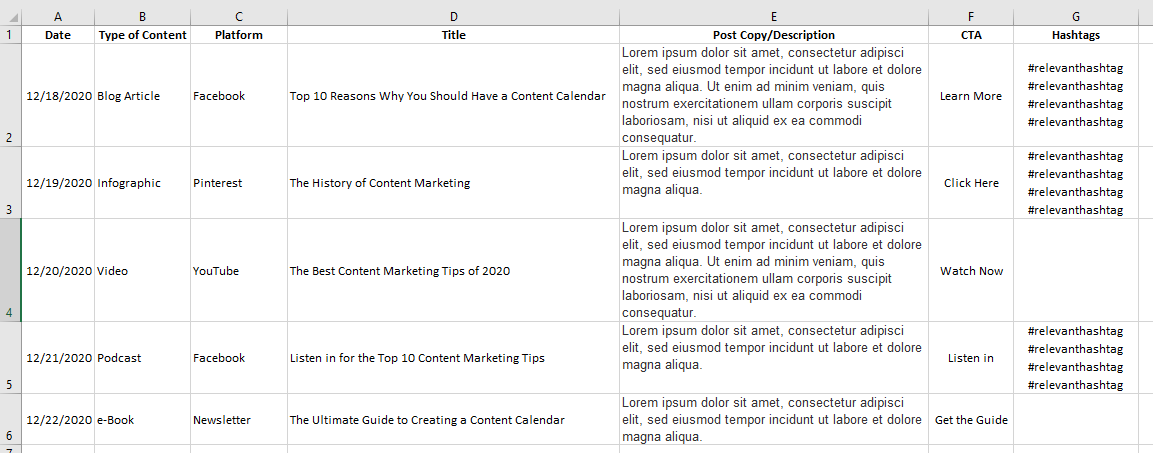Content Marketing 101: How to Create a Content Calendar
What is content marketing?
According to the Content Marketing Institute:
Content marketing is a strategic marketing approach focused on creating and distributing valuable, relevant, and consistent content to attract and retain a clearly-defined audience—and, ultimately, to drive profitable customer action.
Instead of pitching your products or services, you provide relevant, timely, and useful content to your prospects and customers to help them solve their issues. To make this process successful, you should have a documented strategy of how you will bring your content to your audience.
It takes a considerable amount of time to produce well-researched and valuable pieces of content every month, and it’s hard to do that if you don’t have some strategy.
Oddly enough, 63% of businesses don’t have a documented strategy, which means they resort to an ad-lib approach and develop the topics they will cover on the fly. While this has worked for some in the past, it’s not a long-term business solution. Your content marketing strategy should depend on consistency and high quality—and you can’t achieve this without some strategic planning.
So, what does strategic planning look like for a content marketer? It starts with knowing who your target audience is on each platform. From there, it’s essential to understand the types of content that are available to create, the types of content that make sense to create for your business, and the importance of creating a content calendar that resonates with your audience.
What is a content calendar?
A content calendar is a shareable resource that teams can use to plan all content activity throughout the year. Having a calendar-based format, as opposed to just creating a long list of content to be published, comes with several benefits:
- Informs everyone about what is being published, when, and where, so there are no surprises or duplication of efforts.
- Creates a clear vision of how your content is distributed throughout the year.
- You can plan content around key events or important dates.
- Gain a sense of what content still needs to be planned, with plenty of lead time to line up more content.
- Make sure you have your content ready in time to publish when needed.
Why you need a content calendar
Consistency is critical to content success. Unique new ideas and brilliant sparks of creativity are great traits to have in any content marketer, but alone, these traits are too inconsistent and unreliable. Instead, your team needs to be on the same page with what content is being created, plus where and when it’s being published. This gives everyone a better perspective of your overall marketing strategy. A content calendar will also help you notice gaps in the content creation process and prevent you from missing the mark (or a deadline!) with your content.
The keys to content calendar success
Whether you plan content on a weekly, monthly, or quarterly basis, depending on how quickly your industry or organization moves, there are a couple of universal keys to content calendar success:
- Share your calendar with everyone: While not everyone should have the ability to edit a master content calendar, everyone should know where the content calendar is located and have viewing access.
- Add to the calendar regularly: A content calendar is a living, breathing document, and it should change and grow as your content needs grow.
- There’s no one right way to create a content calendar: There are a million different methods, templates, and approaches to take. Find or create a calendar that makes sense for your team.
- Create a content repository: Don’t get stuck on ideas that you can’t implement immediately. Instead, create a repository of content ideas that you can tap into whenever needed.
What should your content calendar include?
No matter what tool you decide to use to create your content calendar, every content calendar should include:
- The date you plan to post
- The type of content (blog post, video, infographic, social media post, podcast, eBook, etc.)
- A headline or title
- Copy for social media or description for a blog post
- A CTA
- Hashtags for social media
- Planned ad spend (if you are promoting a post)
- Tracking codes for links (if you are tracking clickthroughs to a product or service)
In a spreadsheet, the set up for your content calendar might look something like this:

Once you have all your content ideas in place, you can create a calendar to share with your team keeping everyone on the same page.
The key to content marketing success lies in aligning every piece of content with your overall marketing and branding strategy, as well as creating a consistent schedule. For that, you need a detailed content calendar.
All of this may seem like a lot of work to set up initially, but once you have it created, you will save yourself (and your team) a lot of time, energy, and trouble.




